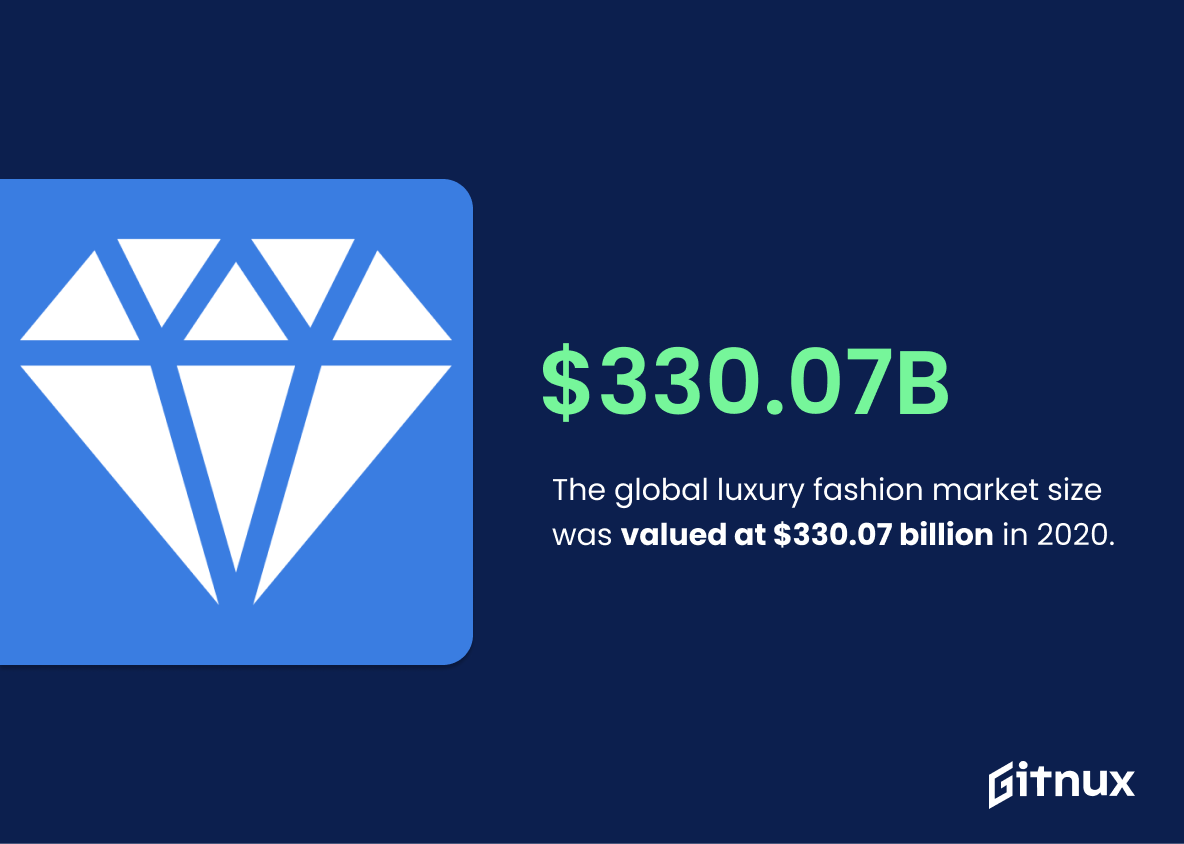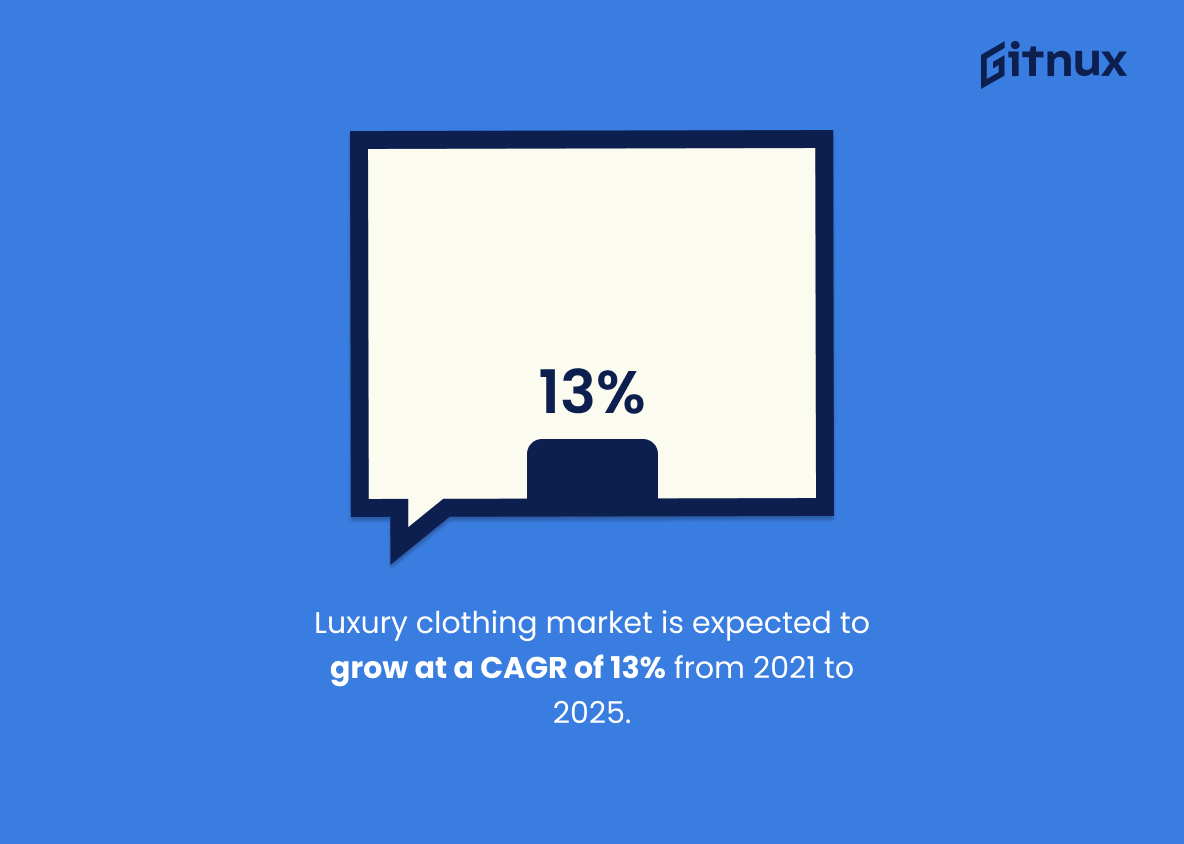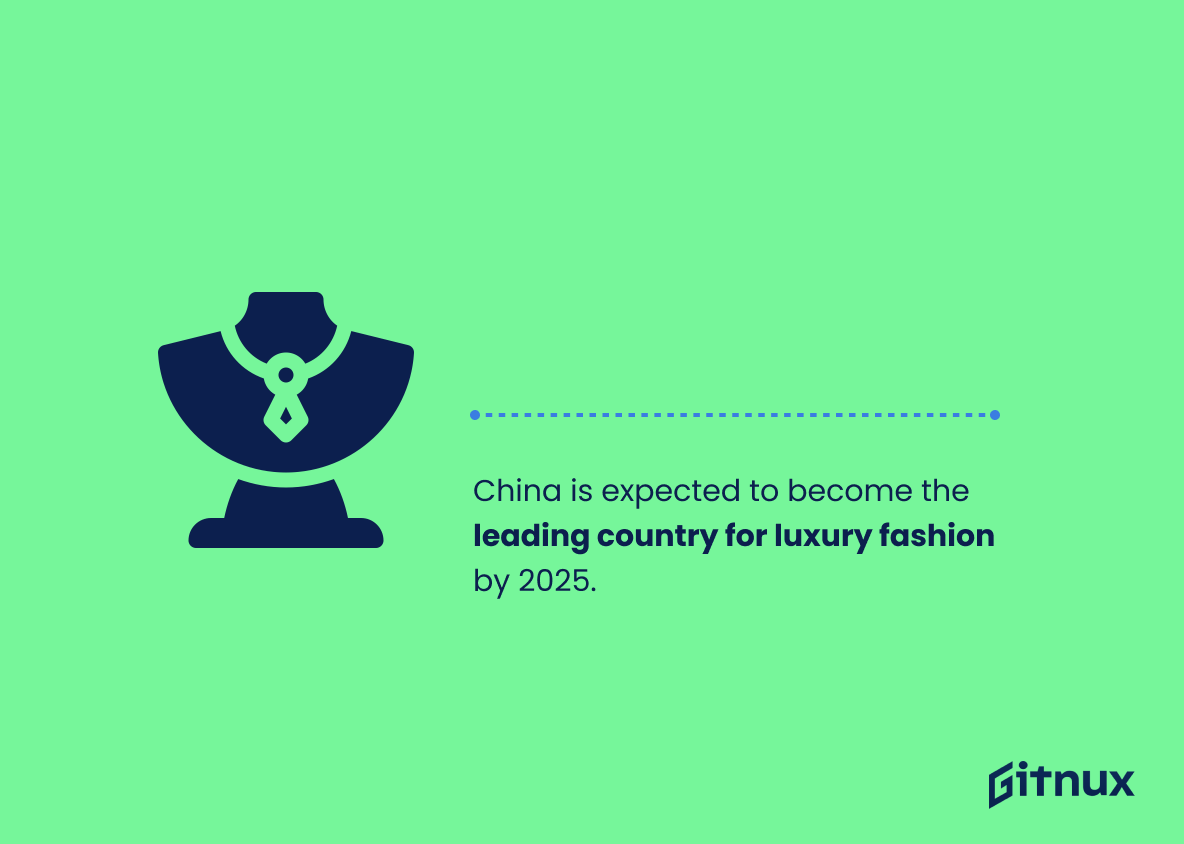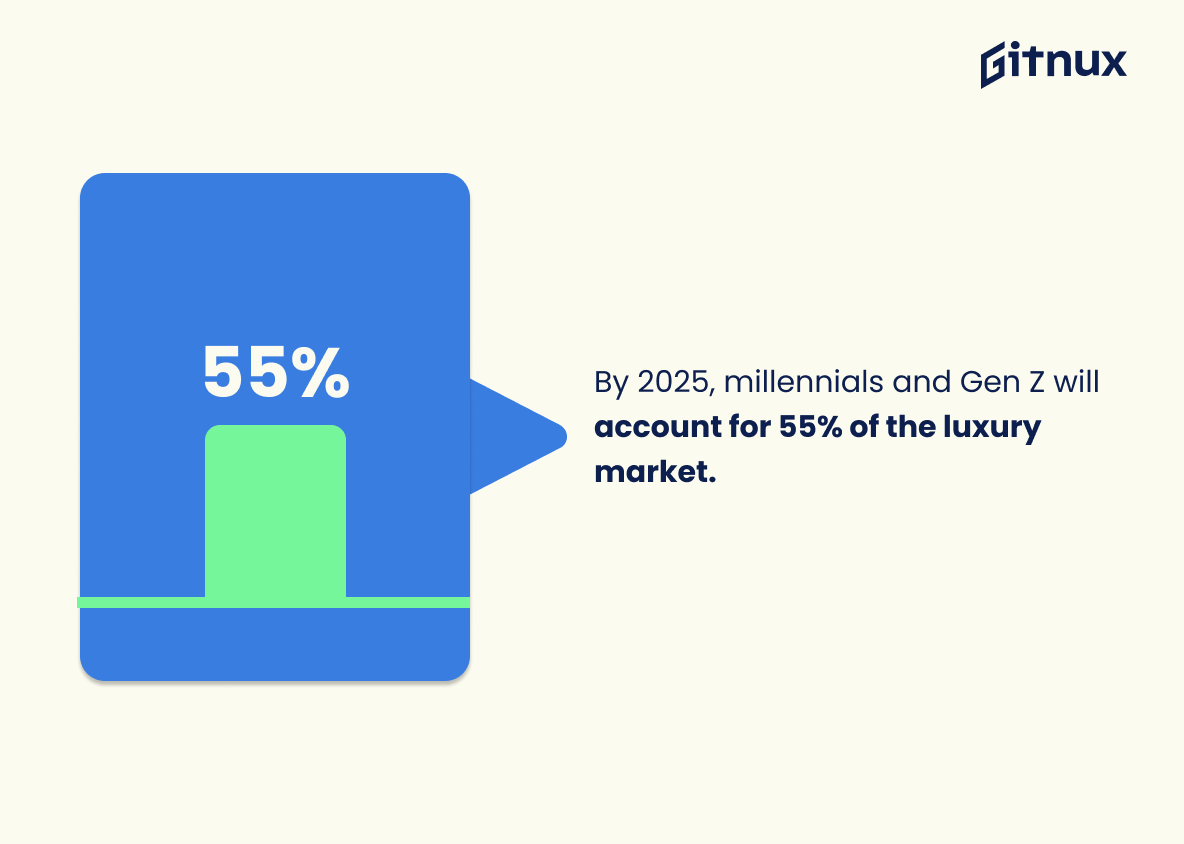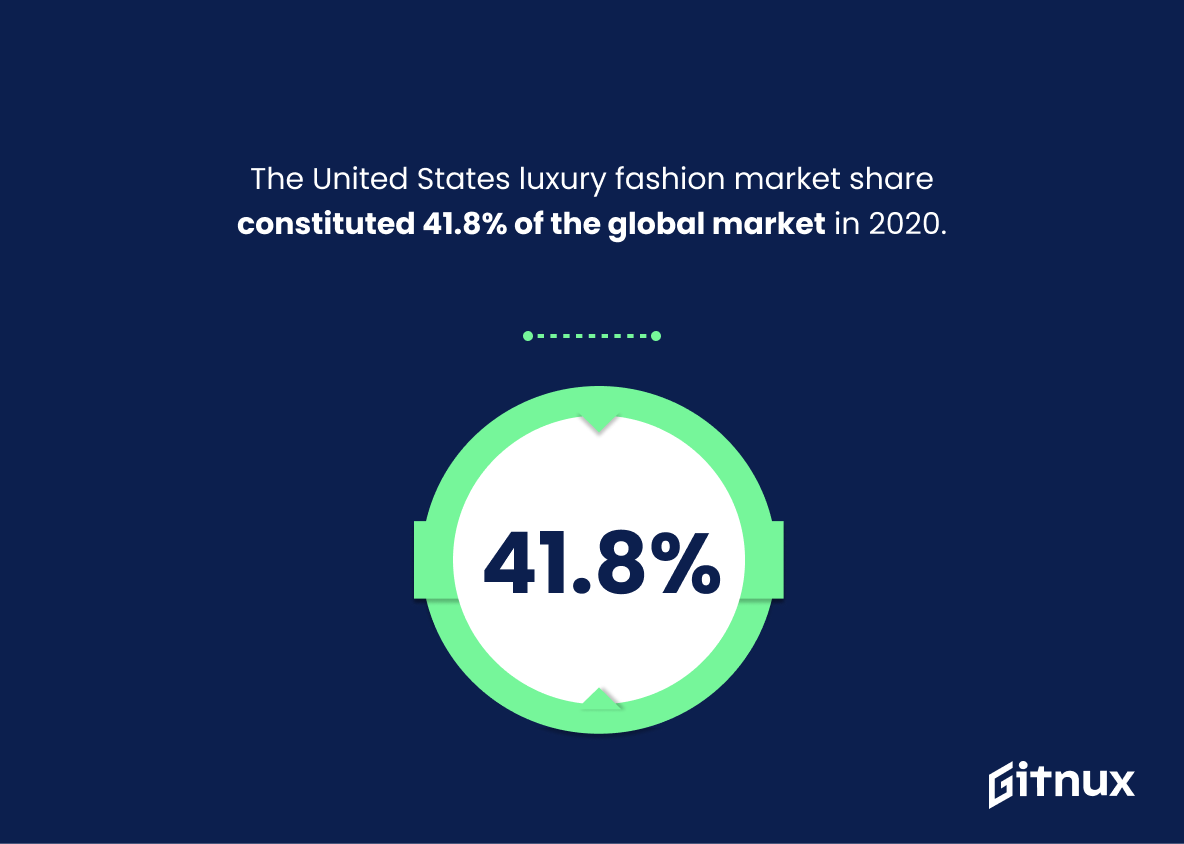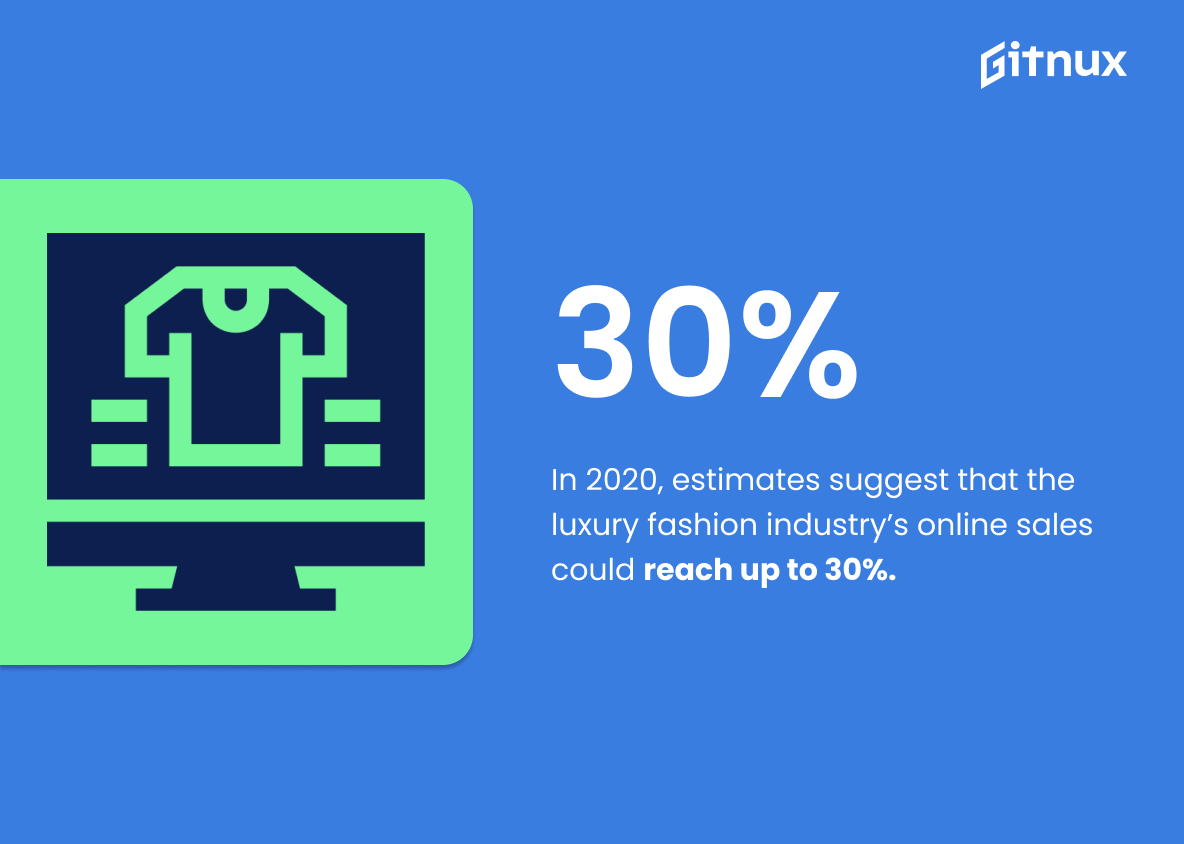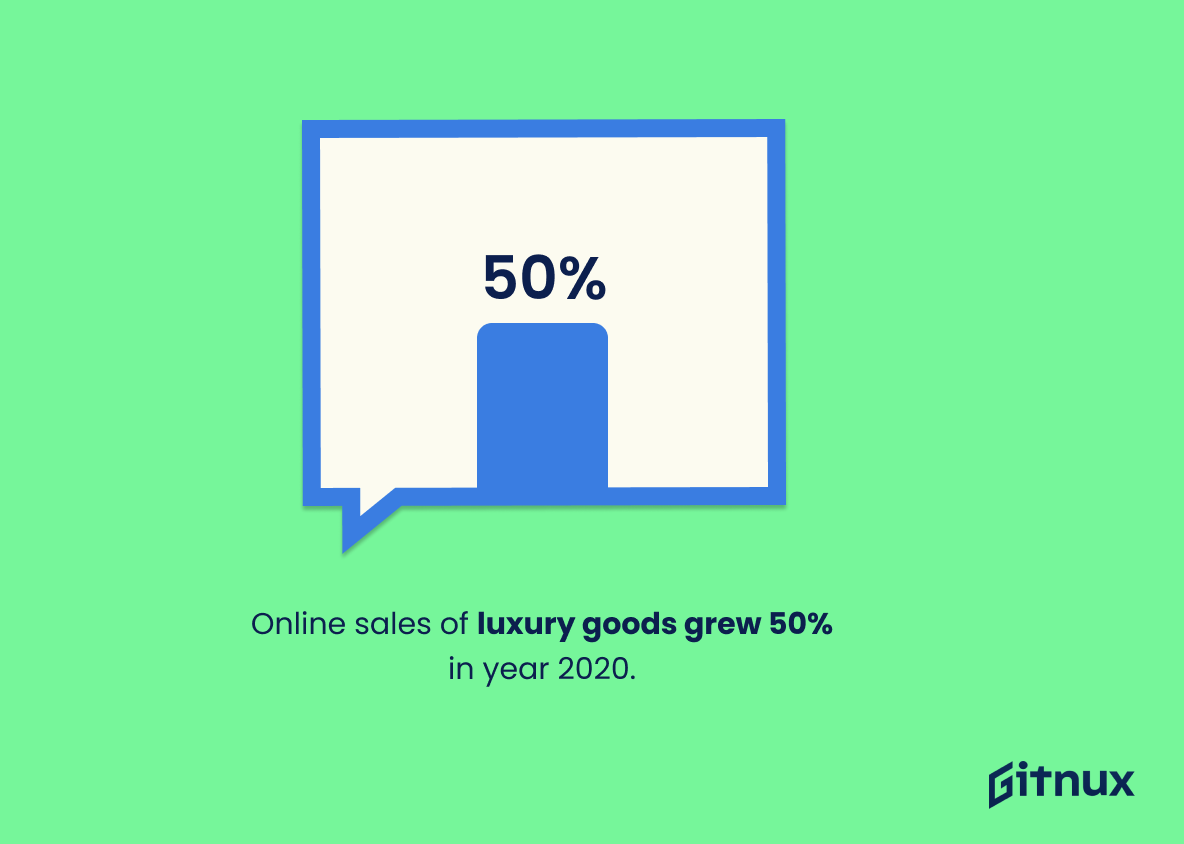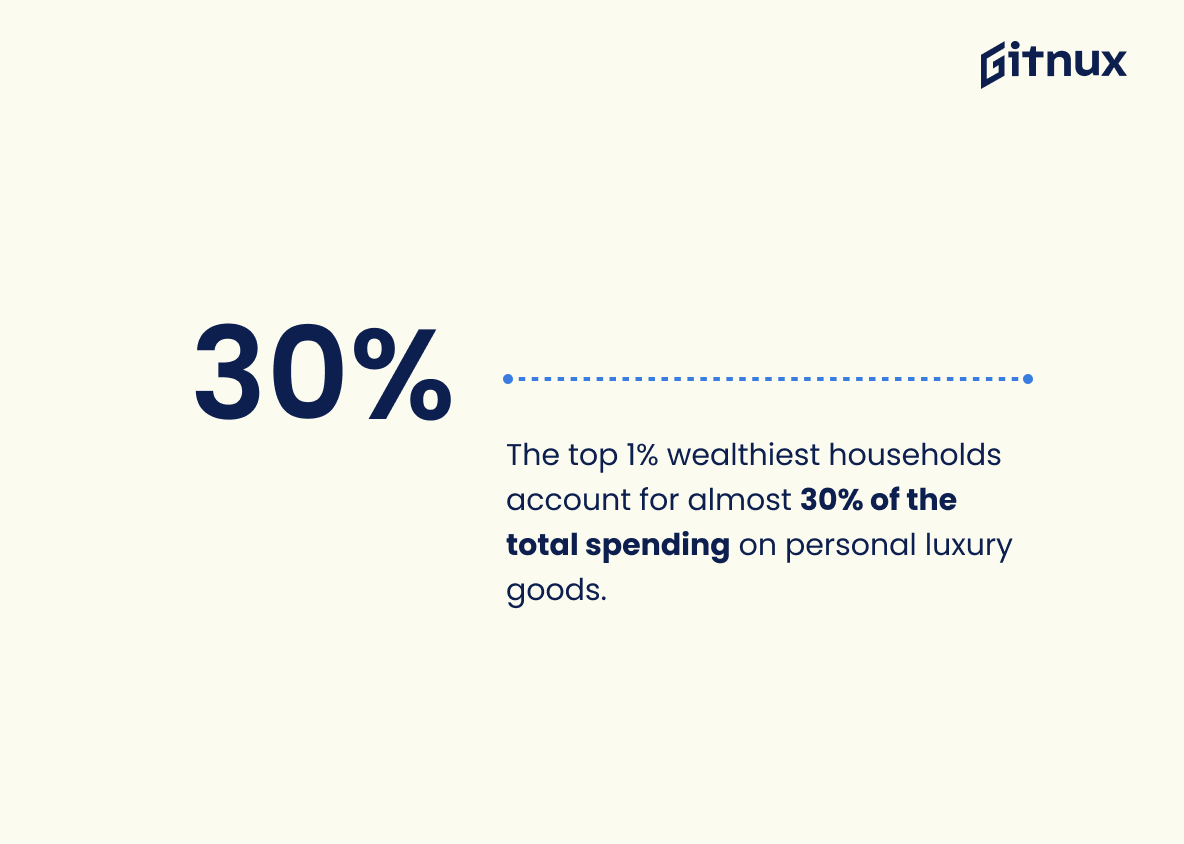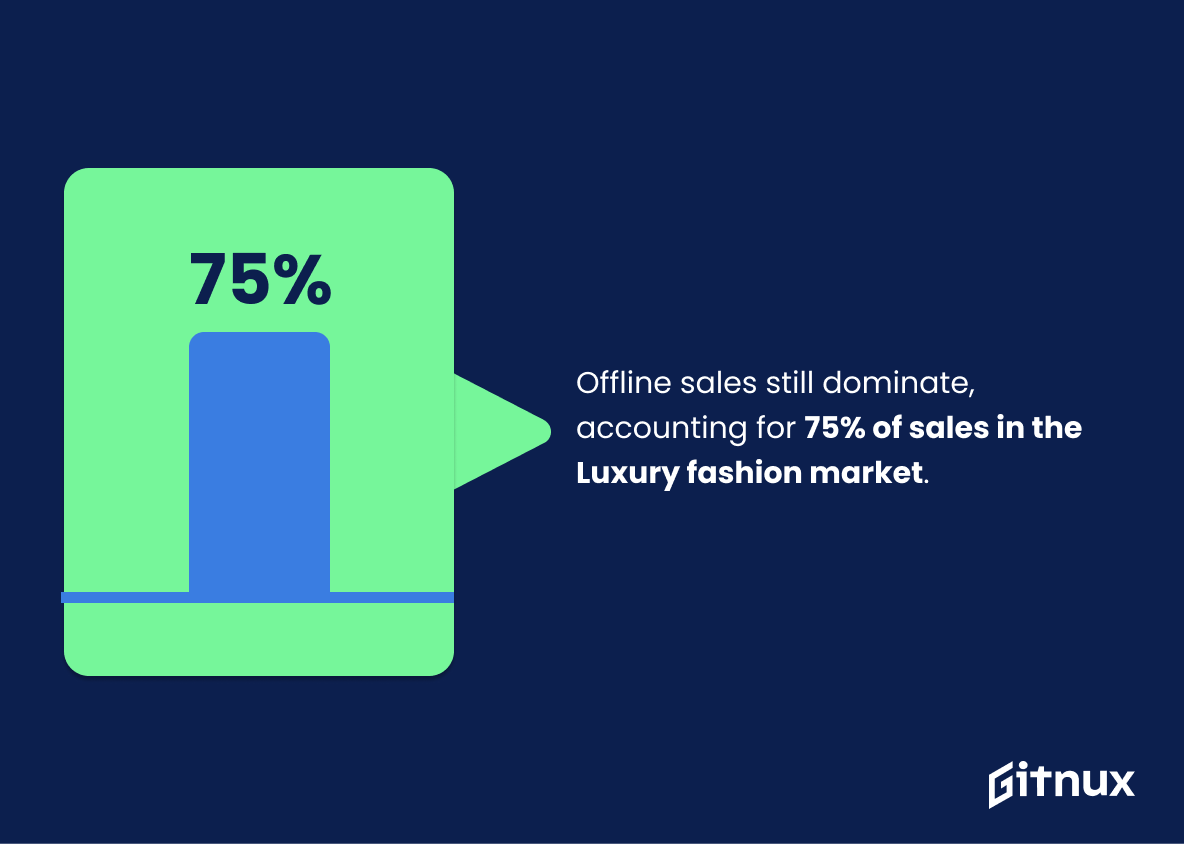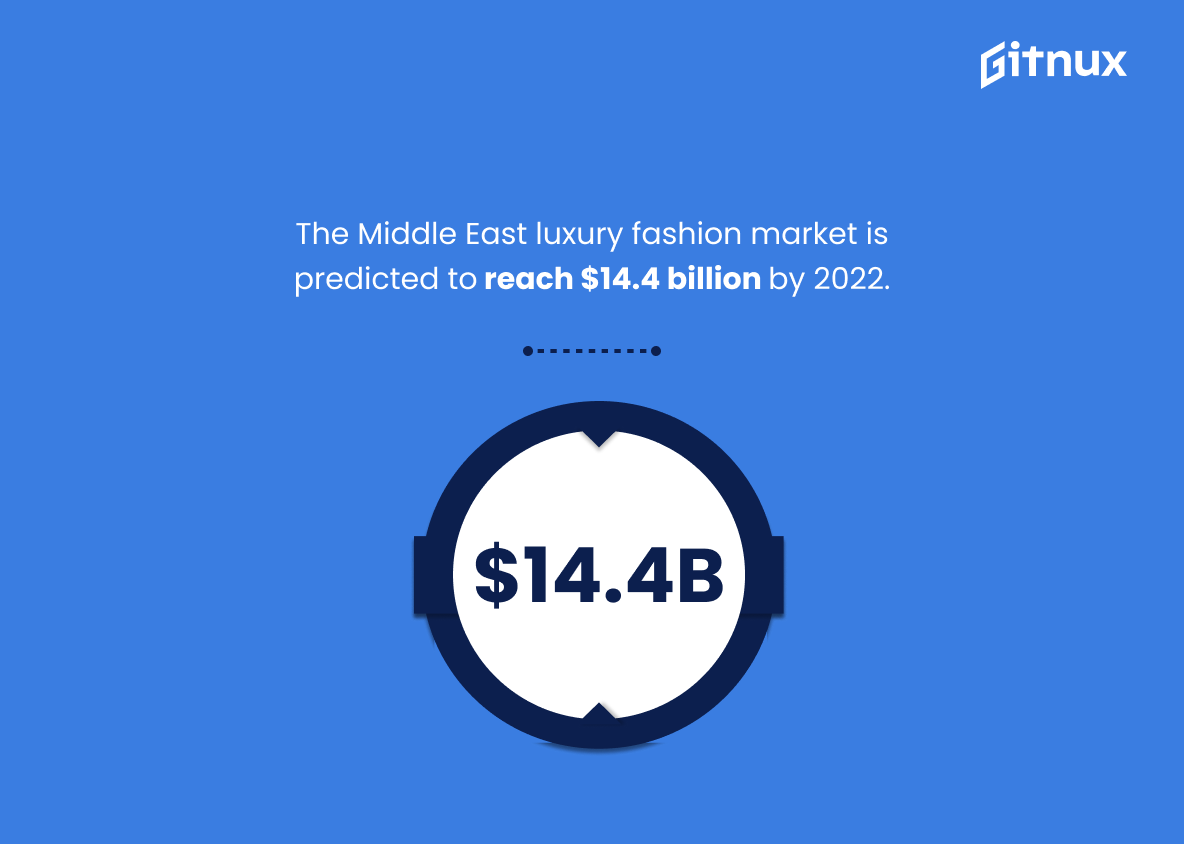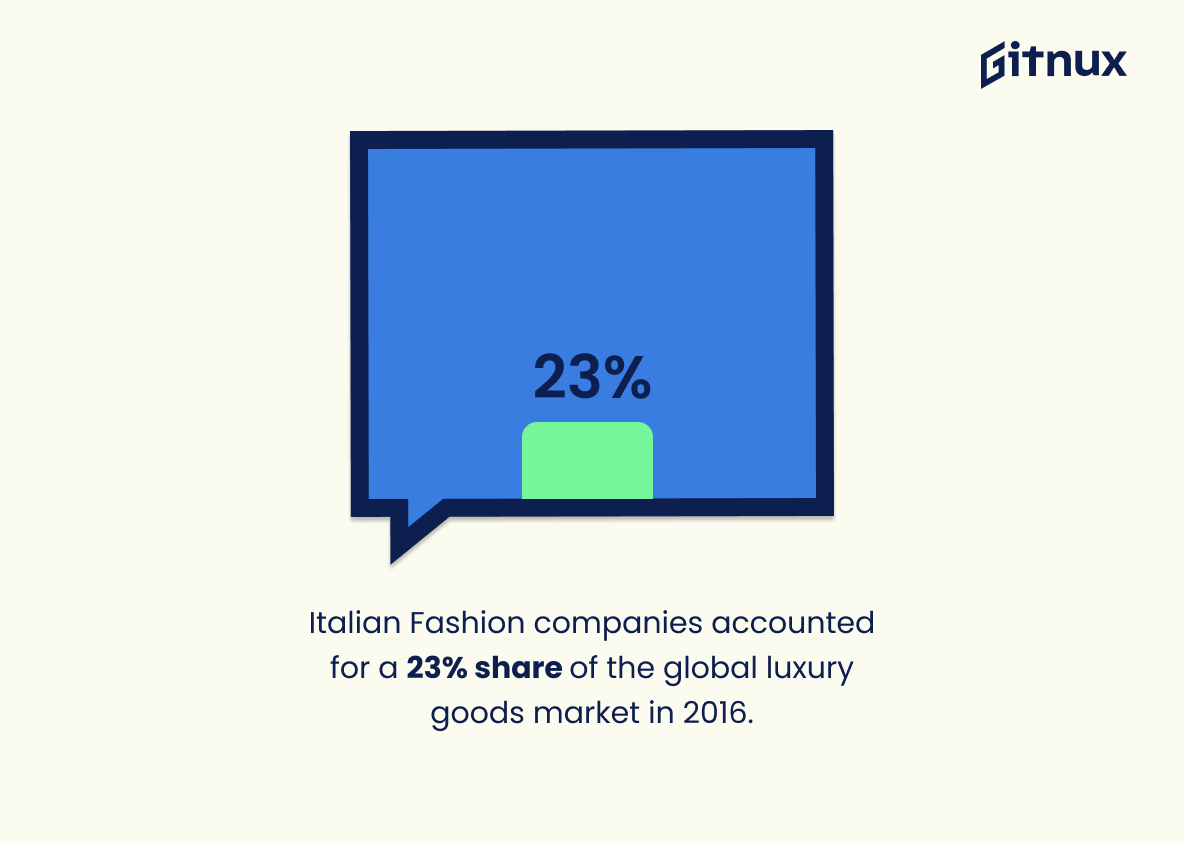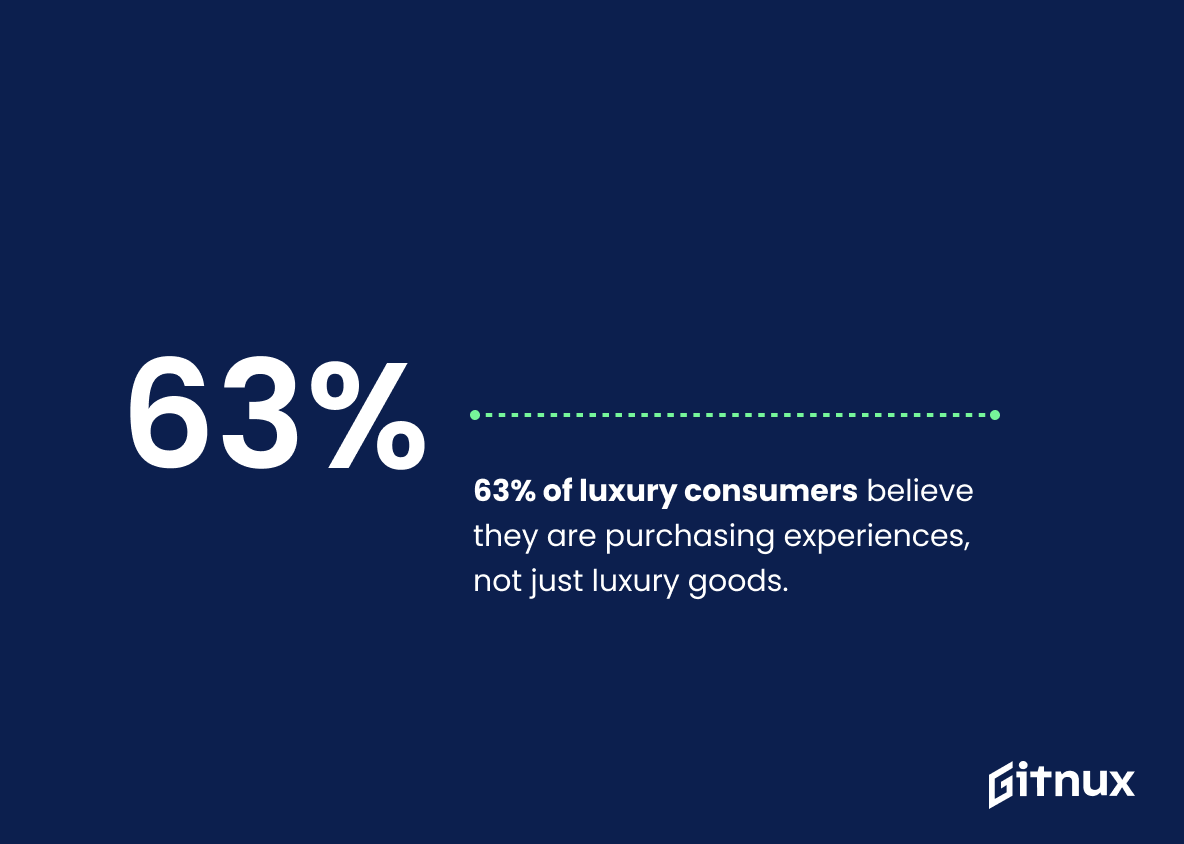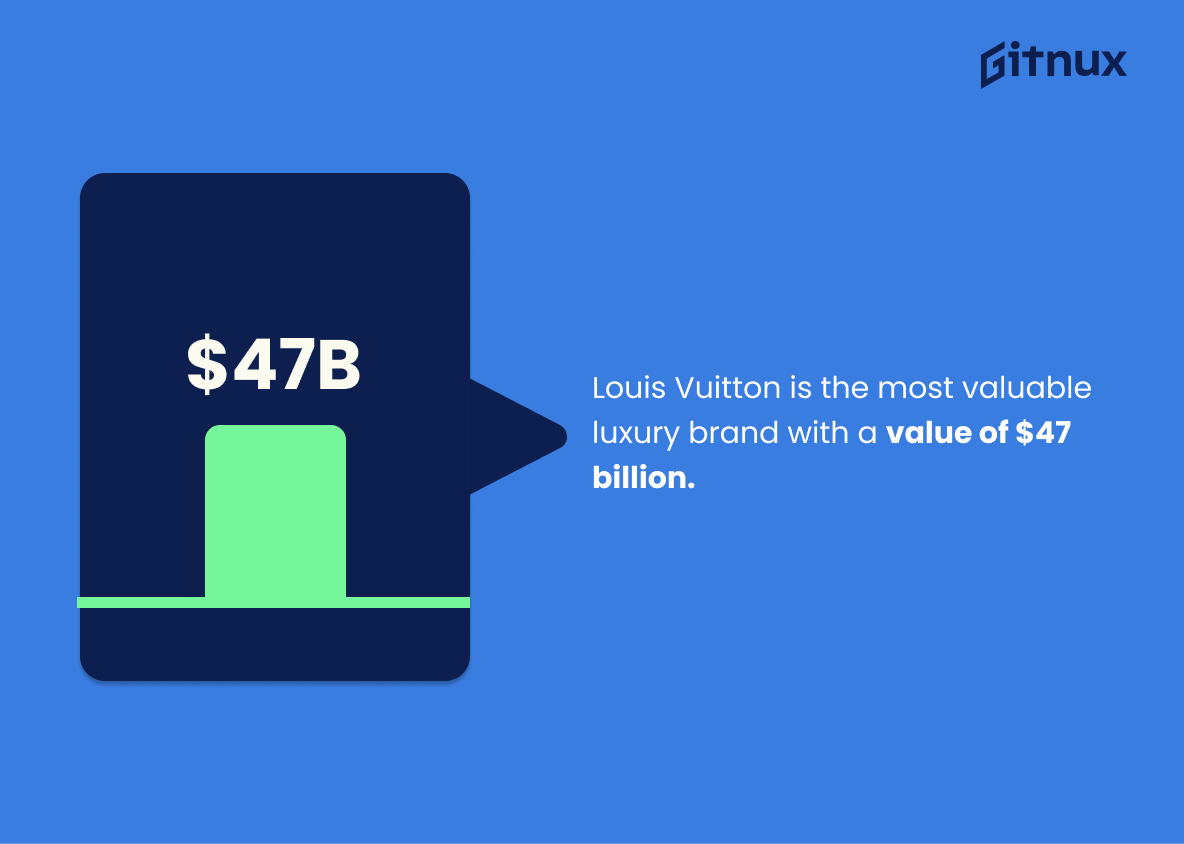As the glitz and glamour of the luxury fashion industry continue to bewitch consumers worldwide, it is worthwhile taking a step back to explore the numerical narrative behind this billion-dollar empire. It’s not just about acclaimed designers, red carpet couture, or the latest must-have Chanel bag, there’s an intriguing matrix of statistics modelling the industry’s operations.
In this exploration, we’ll dive into a sea of numbers and trend analyses, venturing beneath the sartorial surface to demystify the unseen intricacies and illuminate the industry’s economic impact. Join us as we delve into key luxury fashion industry statistics, encapsulating everything from market size and consumer behavior, to digital disruption and sustainability trends.
The Latest Luxury Fashion Industry Statistics Unveiled
The global luxury fashion market size was valued at $330.07 billion in 2020.
Painting a spectacular financial panorama, the colossal valuation of the global luxury fashion market at $330.07 billion in 2020 serves as a resounding testament to the prodigious scale and powerful allure of this sector. With this astronomical number, we are invited to not only marvel at its sheer economic impact, but also comprehend the purchasing power and consumer preference that drive such luxury consumption.
Peeking behind this gargantuan figure also reveals the myriad of stories from luxury fashion brands – of intricate designs, masterful craftsmanship, prestigious legacy, and successful marketing strategies. Thus, this remarkable statistic weaves an integral narrative in the tapestry of our discourse on Luxury Fashion Industry Statistics, helping us understand the sector’s past performance and future potential.
Luxury clothing market is expected to grow at a CAGR of 13% from 2021 to 2025.
Peeling back the layers of the luxury fashion industry, we uncover the pulsing heartbeat of growth – a robust Compound Annual Growth Rate (CAGR) of 13% expected from 2021 to 2025. This numerical testament heralds a potentially thriving future for the industry, painting an enticing panorama for investors and stakeholders. The number acts as a compass, directing strategists in forging plans and policies for upcoming years.
Further, it also encourages aspiring designers and entrepreneurs to stir the cauldron of creativity and innovation, hoping to get a slice from this expanding market pie. Hence, the high-flying trajectory of the luxury clothing market encapsulates its invigorating potential, which surely ignites interest and conversation in a blog post on Luxury Fashion Industry Statistics.
China is expected to become the leading country for luxury fashion by 2025.
Emphasizing the dynamism of the luxury fashion map, this forecast about China’s soaring heights paints a picture of not only a geographical shift, but also a potential strategic pivot in this sector by 2025. In the tapestry of luxury fashion industry statistics, it’s a bold and vibrant thread, a beacon alerting designers, retailers, and investors alike to the enormous potential of the Chinese market.
It’s a critical insight, signaling the dawning of an era where Europe’s long-held dominance may recede in the face of Asia’s rise. That’s the magic and mystery of statistics – the ability to predict a revolution in silk, cashmere and diamonds, and the power to influence where – and for whom – the next season’s luxury lines will be crafted.
By 2025, millennials and Gen Z will account for 55% of the luxury market.
Delving into this illuminating forecast reveals a strategic roadmap for the luxury fashion industry. By 2025, millennials and Gen Z are set to claim the lion’s share – a dominant 55% – of the luxury market. This seismic shift points towards an imminent evolution of the consumer demographic, indicating brands must pivot their appeals to the tastes and influences of these younger generations.
The phenomenal spending power these cohorts are expected to wield, echoes prominent changes in marketing and designing strategies, where sustainability, technological integration, digital engagement and an elevated understanding of their social values will become the keystones of a successful luxury brand. In this future-forward market, the luxury fashion industry will be guided not just by wealth, but by a generation’s unique way of perceiving and interacting with luxury. The statistic serves as the compass, aiming us towards the landscape that will shape tomorrow’s luxury fashion demands.
The United States luxury fashion market share constituted 41.8% of the global market in 2020.
In the grand tapestry of Luxury Fashion Industry Statistics, the considerable thread of United States’ market share shines brightly. Dominating nearly 42% of the global market in 2020, it ascends majestically, showcasing the nation’s heavy influence and significant role within the luxury fashion realm.
A digital bridge to understanding the dynamics of market leadership, consumer purchasing power and trends, this is a clear demonstration of the intertwining synergy of fashion and economics. As you journey through this blog post, keep in mind this impressive number, reflecting the importance and grandeur of the US presence in the global luxury fashion market.
In 2020, estimates suggest that the luxury fashion industry’s online sales could reach up to 30%.
Diving into the heart of the opulence that shimmers around the luxury fashion industry, it’s fascinating to ponder upon an enchanting statistic from 2020. A swift, shimmering rise in the potential of online sales in this niche was projected, beckoning a robust shift in traditional business models.
It was anticipated that the luxury fashion universe could witness online sales rocket to a whopping 30%. This intriguing statistic would be a headliner, illustrating a trend towards digitalization in an industry that once steadfastly held onto its brick-and-mortar showrooms.
In a world increasingly painted with digital strokes, this tells us how luxury fashion brands are also draping themselves in this new-age couture to keep up. With ever-evolving consumer behavior, stronger internet penetration and advent of technological masterstrokes like Virtual Reality or Augmented Reality, the industry’s maneuver towards the e-commerce platform sketches a significant outline of its growth and resilience, providing key points for discussion in a blog post delving into Luxury Fashion Industry Statistics.
Online sales of luxury goods grew 50% in year 2020.
The enchantment of this numeral, a resounding 50% growth in online sales of luxury goods in the 2020 roller coaster, paints an illustrative paradigm shift in the luxury fashion industry. Amidst a global pandemic, it resonates the undying allure of richness, hinting at the industry’s extraordinary adaptability to rise from the ashes of the physical retail downfall.
Witnessing such an astounding surge, it echoes loud the potency of digital platforms as the new couturiers, indicating a new era where luxury courtyards go virtual. Ultimately, it’s a testament to the industry’s resilience, keeping the state of fashion opulence alive, and thriving, even amidst global turmoil.
The top 1% wealthiest households account for almost 30% of the total spending on personal luxury goods.
Peeling back a layer of the Luxury Fashion Industry’s gleaming facade reveals a stark dependency on the world’s elite, underscoring an economy resting heavily on a minute fraction of the global population. It is riveting to uncover that a staggering 30% of total expenditure on personal luxury goods can be traced back to the top 1% of the wealthiest households. This statistic hints at the quintessential role these affluent households play in driving the industry, turning it into a dazzling spectacle of wealth display.
This phenomenon intertwines the industry’s survival and growth with the economic health of the wealthiest segment, rendering it vulnerable to their spending habits and economic volatility. It also showcases the degree of economic inequality and spending power concentration in the world, a theme that thoroughly permeates the indulgent universe of luxury fashion.
This spectacle of wealth concentration isn’t just a line in an earnings report; it’s a driving force that molds market trends and navigates product development across the luxury fashion industry.
Offline sales still dominate, accounting for 75% of sales in the Luxury fashion market.
Delving into the dynamics of the Luxury Fashion Industry, it’s rather intriguing to note how offline sales hold an undeniable supremacy with a staggering 75% hold on the market. This sizable demographic plays an essential role in shaping strategies and driving growth within the industry. It portrays the enduring allure of tangible, in-person shopping experiences, particularly when it comes to luxury fashion purchases where customers tend to value the tactile engagement and personalized service associated with brick-and-mortar stores.
Furthermore, it encourages industry players to sustain their investment in physical boutiques and elevates the significance of these traditional retail outlets in defining the industry landscape. Lastly, it empowers them to integrate and innovate their offline and online presence for a holistic luxury shopping experience.
The Middle East luxury fashion market is predicted to reach $14.4 billion by 2022.
Foretelling the prodigious expansion of the Middle East luxury fashion market, reaching a spectacular $14.4 billion by 2022, illustrates the soaring demand and thriving opportunities in this region. For aficionados scribbling about Luxury Fashion Industry Statistics on weblogs, this statistic serves as a compelling argument to highlight the region’s potential.
It’s akin to painting a vivid canvas showcasing the economic clout and consumer appetite in the Middle East, drawing attention to its pivotal role in shaping the future trajectory of the global luxury fashion landscape.
France’s luxury sector generated sales of €27 billion ($31.8 billion) in 2019.
The chime of cash registers echo remarkably loud in France, where the luxury sector alone crowned the grand sum of €27 billion ($31.8 billion) in sales as of 2019. Such a majestic figure not only illustrates the robust health of France’s high-end market but also underlines the country’s prominent role in the global luxury fashion landscape.
This monetary masterstroke signifies that France, as a trend-setting nation, continues to weave a profound influence in shaping fashion aspirations and fueling consumer desires worldwide. The powerful performance of France’s luxury industry forms a golden thread in the grand tapestry of global luxury fashion industry statistics.
Italian Fashion companies accounted for a 23% share of the global luxury goods market in 2016.
This arresting statistic underscores the role of Italian fashion companies as a powerful tour de force within the global luxury goods landscape in 2016. Commanding a substantial 23% share of the market underscores Italy’s influential place on the high-fashion chess board. It paints an image of Italy as a chamber of fashion innovation, echoing a storied narrative of refined craftsmanship, design excellence and quality.
For any industry insider or enthusiast reading this blog post, this metric puts into perspective the scale at which Italian couturiers shape global luxury trends. It’s not just a testament to the historical prestige of Italian luxury fashion, but an indicator of how it continues to wield considerable clout in shaping the tapestry of global luxury consumption.
63% of luxury consumers believe they are purchasing experiences, not just luxury goods.
Illuminating the realm of the luxury fashion industry, we unearth the intriguing insight that an overwhelming 63% of luxury consumers view their purchases as not merely procuring goods, but investing in experiences. This compelling statistic is a shimmering thread in a fascinating tapestry which reveals the dynamism of consumer behavior in the luxury fashion industry.
The substantiated figure ignites a new depth in our understanding, emphasizing that the narrative of luxury isn’t confined to mere ownership of high-end products. Rather, it’s about the unique user experience tied to the brands. This includes the immersive showroom experiences, exceptional customer service, and the prestige associated with brand ownership, all of which have a psychological payoff for the consumer.
A spotlight on this statistic revolutionizes our perception of the luxury market, and subtly weaves itself into the interactive narrative of the fashion industry. Thus, this captivating statistic is a quintessential cornerstone in the understanding and forecasting of future trends, consumer behavior shifts and strategies to successfully cater to the ever-evolving luxury consumer.
Louis Vuitton is the most valuable luxury brand with a value of $47 billion.
In the realm of fashion, where every sequin and stitch is of consequence, the towering valuation of Louis Vuitton, riding high at $47 billion, serves as a diamond-studded benchmark for success in the luxury industry. This figure isn’t just a mere number but an emblem of consequence, symbolizing the zenith of allure, quality, and desirability that other brands strive to emulate.
As we glide down the haute couture runway of luxury fashion industry statistics, this stunning revelation sets the stage, dictating the glitz and glamour narrative and adding compelling context and perspective to the discourse. Henceforth, this understated attribute of Louis Vuitton provides an integral cornerstone, helping us to unravel the intricate tapestry of the high-end fashion landscape.
The net profit of the fashion brand Gucci was approximately 3.21 billion euros in 2019.
Insight into the net profit of the fashion powerhouse Gucci leaves an impressive mark on the landscape of the Luxury Fashion Industry Statistics. Clocking in at approximately 3.21 billion euros in 2019, this figure not only underlines the brand’s dominant position, but also encapsulates the buying power and demand within the luxury fashion market.
An examination of this staggering profit drives home the potential for extravagance and success carved out by icons of style like Gucci within the luxury sector. This morsel of data serves as an economic compass—no doubt directing followers of fashion towards trends, influencing decision making of entrepreneurs, and providing aspiring luxury brands an economic benchmark. The fashion industry, after all, is as much about style as it is about the substantial payday for those brands that balance timeless appeal with modern desires.
Demand for luxury sneakers and streetwear grew by about 40% in 2019.
Unveiling a robust 40% surge in the demand for luxury sneakers and streetwear in 2019 paints a vivid picture of not just high-end street fashion’s growing significance in the fashion industry, but also highlights the rapidly transforming consumer preferences. This remarkable uptick underscores the mushrooming influence of street culture on luxury fashion, ushering a seismic shift in the artistic direction of major fashion houses.
This illuminates the pivotal need for brands to revolutionize their creative strategies to resonate with this dynamic trend. It also gestures towards an encouraging commercial opportunity in the luxury segment, inviting the industry to innovate and adapt to the evolving tastes of its consumer base. With the increasing clout of streetwear aesthetics in luxury fashion, this statistic allows us an intriguing glimpse into the future direction that high-end fashion might be headed towards.
The global market for pre-owned luxury fashion items is expected to grow at a compound annual growth rate (CAGR) of up to 15% in the coming years.
Exploring the dynamic world of luxury fashion, it becomes evident that the tides are turning with a projected shift towards the pre-owned sector. Imagine threads of couture tracing a dramatic upward trajectory – that’s the power of second-hand luxury goods, poised to surge ahead with a CAGR of up to 15% in coming years.
From the vantage point of this statistic, the luxury fashion industry’s landscape is not just reshaping itself, but it’s growing at a pace that cannot be ignored. This evolution presents an exciting narrative, redefining the concept of timeless fashion, even as it drives home the profitability of sustainability in a market once dominated by the brand-new and the shiny.
Women represent 85% of all luxury brand purchases.
In the glittering realm of the luxury fashion industry, the veil lifts to reveal a powerful narrative – a full-bodied 85% of all luxury brand purchases are made by women. This compelling statistic paints a vibrant portrait of women as the primary catalysts stoking the flames of the luxury market.
Let this garnish the perception of the luxury fashion industry, underscoring the substantial influence of women in shaping and driving these high-end markets. Hence, it anchors any discourse on luxury fashion industry statistics, underlining the imperative to tailor strategies and narratives towards this dominant market demographic.
82% of luxury brands are planning to increase their budgets for influencer marketing.
Diving into the world of opulence and elegance that characterizes the luxury fashion industry, one cannot overlook the profound impact of influencer marketing. Imagine the power of influencers, commanding armies of followers, setting trends, and shifting tastes globally. Now picture this – a whopping 82% of luxury brands are poised to inject more finances into influencer marketing. This denotes a pivotal shift in the marketing strategies of these fashion powerhouses.
Their willingness to up their stakes in influencer marketing not only emphasizes the magnitude of its influence but also pinpoints the crucial role it’ll undeniably play in the future of luxury fashion. Without question, these luxury brands have discerned the unparalleled returns and amplified visibility this marketing channel offers. It’s imperative for those navigating the luxury fashion terrain to recognize this mounting trend, as it denotates the path industry leaders are charting.
Conclusion
To wrap it up, the luxury fashion industry continues to prove its resilience and versatility, thriving in a fast-paced global market. The industry is not only driven by exclusivity and quality craftsmanship, but also by a steady stream of fashion-conscious consumers who value authenticity, sustainability, and personalized experiences. Evolving trends, digitalization, and emergent markets are reshaping the sector, bringing both challenges and opportunities at every turn.
Therefore, understanding these Luxury Fashion Industry statistics is crucial for anyone interested in cultivating a successful brand and staying competitive in this highly vibrant industry. The numbers don’t lie and are invaluable for guiding strategies, making informed decisions, and ultimately, achieving sustained growth in the world of luxury fashion.
References
0. – https://www.www.technavio.com
1. – https://www.www.mckinsey.com
2. – https://www.www.bain.com
3. – https://www.www.france24.com
4. – https://www.www.bcg.com
5. – https://www.www.statista.com
6. – https://www.www.modaes.com
7. – https://www.www.businessoffashion.com
8. – https://www.www.forbes.com
9. – https://www.www.launchmetrics.com
10. – https://www.www2.deloitte.com
11. – https://www.www.reuters.com
12. – https://www.retail-insider.com
13. – https://www.www.grandviewresearch.com
14. – https://www.www.marketdataforecast.com
